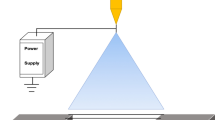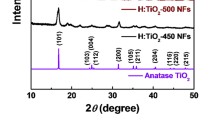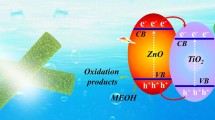Abstract
Graphitic carbon nitride nanosheets (g-C3N4 NSs) hybridized nitrogen doped titanium dioxide (N-TiO2) nanofibers (GCN/NT NFs) have been synthesized in situ via a simple electrospinning process combined with a modified heat-etching method. The prepared GCN/NT NFs were characterized by a variety of methods and their photocatalytic activities were evaluated by hydrogen (H2) production from water splitting and degradation of rhodamine B in aqueous solution. It was found that the GCN/NT NFs have a mesoporous structure, composed of g-C3N4 NSs and N-doped TiO2 crystallites. The g-C3N4 NSs synthesized after heat-etching were found to be embedded in, and covered, the hybrid NFs to form stable interfaces. The partial decomposition of g-C3N4 releases its nitrogen content which eventually gets doped into the nearby TiO2 skeleton. The GCN/NT NFs give a high photocatalytic H2 production rate of 8,931.3 μmol·h−1·g−1 in aqueous methanol solution under simulated solar light. Such a highly efficient photocatalytic performance can be ascribed to the combined effects of g-C3N4 NSs and N-doped TiO2 with enhanced light absorption intensity and improved electron transport ability. Also, the large surface area of the mesoporous NFs minimizes light reflection on the surface and provides more surface-active sites. This work highlights the potential of quasi-one dimensional hybrid materials in the field of solar energy conversion.

Similar content being viewed by others
References
Wang, H. L.; Zhang, L. S.; Chen, Z. G.; Hu, J. Q.; Li, S. J.; Wang, Z. H.; Liu, J. S.; Wang, X. C. Semiconductor heterojunction photocatalysts: Design, construction, and photocatalytic performances. Chem. Soc. Rev. 2014, 43, 5234–5244.
Cao, S. W.; Yu, J. G. G-C3N4-based photocatalysts for hydrogen generation. J. Phys. Chem. Lett. 2014, 5, 2101–2107.
Fujishima, A.; Honda, K. Electrochemical photolysis of water at a semiconductor electrode. Nature 1972, 238, 37–38.
**ang, Q. J.; Yu, J. G.; Jaroniec, M. Synergetic effect of MoS2 and graphene as cocatalysts for enhanced photocatalytic H2 production activity of TiO2 nanoparticles. J. Am. Chem. Soc. 2012, 134, 6575–6578.
Ong, W. J.; Tan, L. L.; Chai, S. P.; Yong, S. T.; Mohamed, A. R. Self-assembly of nitrogen-doped TiO2 with exposed {001} facets on a graphene scaffold as photo-active hybrid nanostructures for reduction of carbon dioxide to methane. Nano Res. 2014, 7, 1528–1547.
Wu, N.; Wang Y. D.; Lei, Y. P.; Wang, B. Preparation and photocatalytic activity of N-Ag co-doped TiO2/C porous ultrafine fibers mat. Ceram. Int. 2014, 40, 2017–2022.
Nguyen, N. T.; Yoo, J. E.; Altomare, M.; Schmuki, P. “Suspended” Pt nanoparticles over TiO2 nanotubes for enhanced photocatalytic H2 evolution. Chem. Commun. 2014, 50, 9653–9656.
Zhou, W.; Li, T.; Wang, J. Q.; Qu, Y.; Pan, K.; **e, Y.; Tian, G. H.; Wang, L.; Ren, Z. Y.; Jiang, B. J. et al. Composites of small Ag clusters confined in the channels of well-ordered mesoporous anatase TiO2 and their excellent solar-light-driven photocatalytic performance. Nano Res. 2014, 7, 731–742.
Wang, P.; Han, L.; Zhu, C. Z.; Zhai, Y. M.; Dong, S. J. Aqueous-phase synthesis of Ag-TiO2-reduced graphene oxide and Pt-TiO2-reduced graphene oxide hybrid nanostructures and their catalytic properties. Nano Res. 2011, 4, 1153–1162.
Asahi, R.; Morikawa, T.; Ohwaki, T.; Aoki, K.; Taga, Y. Visible-light photocatalysis in nitrogen-doped titanium oxides. Science 2001, 293, 269–271.
Zhang, H. J.; Xu, P. P.; Du, G. D.; Chen, Z. W; Oh, K.; Pan, D. Y.; Jiao, Z. A facile one-step synthesis of TiO2/graphene composites for photodegradation of methyl orange. Nano Res. 2011, 4, 274–283.
Shen, J. F.; Shi, M.; Ma, H. W.; Li, N.; Ye, M. X. Ionic liquid-assisted one-step hydrothermal synthesis of TiO2-reduced graphene oxide composites. Nano Res. 2011, 4, 795–806.
Chen, C. C.; Ma, W. H.; Zhao, J. C. Semiconductor-mediated photodegradation of pollutants under visible-light irradiation. Chem. Soc. Rev. 2010, 39, 4206–4219.
Shi, J. L. On the synergetic catalytic effect in heterogeneous nanocomposite catalysts. Chem. Rev. 2013, 113, 2139–2181.
Wang, X. C.; Maeda, K.; Thomas, A.; Takanabe, K.; **n, G.; Carlsson, J. M.; Domen, K.; Antonietti, M. A metal-free polymeric photocatalyst for hydrogen production from water under visible light. Nat. Mater. 2009, 8, 76–80.
Chai, B.; Peng, T. Y.; Mao, J.; Li, K.; Zan, L. Graphitic carbon nitride (g-C3N4)-Pt-TiO2 nanocomposite as an efficient photocatalyst for hydrogen production under visible light irradiation. Phys. Chem. Chem. Phys. 2012, 14, 16745–16752.
Yu, J. G.; Wang, S. H.; Low, J. X.; **ao, W. Enhanced photocatalytic performance of direct Z-scheme g-C3N4/TiO2 photocatalyst for decomposition of formaldehyde in air. Phys. Chem. Chem. Phys. 2013, 15, 16883–16890.
Muñoz-Batista, M. J.; Kubacka, A.; Fernández-García, G. Effect of g-C3N4 loading in TiO2-based photocatalysts: UV and visible degradation of toluene. Catal. Sci. Technol. 2014, 4, 2006–2015.
Liu, G.; Yang, H. G.; Wang, X.; Cheng, L.; Pan, J.; Lu, G. Q.; Cheng, H. M. Visible light responsive nitrogen doped anatase TiO2 sheets with dominant {001} facets derived from TiN. J. Am. Chem. Soc. 2009, 131, 12868–12869.
Wang, Y. J.; Shi, R.; Lin, J.; Zhu, Y. F. Enhancement of photocurrent and photocatalytic activity of ZnO hybridized with graphite-like C3N4. Energy Environ. Sci. 2011, 4, 2922–2929.
Huang, L. Y.; Xu, H.; Li, Y. P.; Li, H. M.; Cheng, X. N.; **a, J. X.; Xu Y. G.; Cai, G. B. Visible-light-induced WO3/g-C3N4 composites with enhanced photocatalytic activity. Dalton Trans. 2013, 42, 8606–8616.
Zhou, S.; Liu, Y.; Li, J. M.; Wang, Y. J.; Jiang, G. Y.; Zhao, Z.; Wang, D. X.; Duan, A. H.; Liu, J.; Wei, Y. C. Facile in situ synthesis of graphitic carbon nitride (g-C3N4)-N-TiO2 heterojunction as an efficient photocatalyst for the selective photoreduction of CO2 to CO. Appl. Catal. B-environ. 2014, 158, 20–29.
Kim, C. H.; Kim, B. H.; Yang, K. S. TiO2 nanoparticles loaded on graphene/carbon composite nanofibers by electrospinning for increased photocatalysis. Carbon 2012, 50, 2472–2481.
Wang, W. J.; Yu, J. C.; **a, D. H.; Wong, P. K.; Li, Y. C. Graphene and g-C3N4 nanosheets cowrapped elemental α-sulfur as a novel metal-free heterojunction photocatalyst for bacterial inactivation under visible-light. Environ. Sci. Technol. 2013, 47, 8724–8732.
Yang, S. B.; Gong, Y. J.; Zhang, J. S.; Zhan, L.; Ma, L. L.; Fang, Z. Y.; Vajtai, R.; Wang, X. C.; Jayan, P. M. Exfoliated graphitic carbon nitride nanosheets as efficient catalysts for hydrogen evolution under visible light. Adv. Mater. 2013, 25, 2452–2456.
Niu, P.; Zhang, L. L.; Liu, G.; Cheng, H. M. Graphene-like carbon nitride nanosheets for improved photocatalytic activities. Adv. Funct. Mater. 2012, 22, 4763–4770.
Wang, W. J.; Yu, J. C.; Shen, Z. R.; Chan, D. K. L.; Gu, T. g-C3N4 quantum dots: Direct synthesis, upconversion property and photocatalytic application. Chem. Commun. 2014, 50, 10148–10150.
Wang, Y. D.; Han, C.; Zheng, D. C.; Lei, Y. P. Large-scale, flexible and high-temperature resistant ZrO2/SiC ultrafine fibers with a radial gradient composition. J. Mater. Chem. A 2014, 2, 9607–9612.
Zhang, C. L.; Yu, S. H. Nanoparticles meet electrospinning: Recent advances and future prospects. Chem. Soc. Rev. 2014, 43, 4423–4448.
Fu, J. W.; Cao, S. W.; Yu, J. G.; Low, J. X.; Lei, Y. P. Enhanced photocatalytic CO2-reduction activity of electrospun mesoporous TiO2 nanofibers by solvothermal treatment. Dalton Trans. 2014, 43, 9158–9165.
Wu, N.; Wang, Y. D.; Lei, Y. P.; Wang, B.; Han, C. Flexible N-doped TiO2/C ultrafine fiber mat and its photocatalytic activity under simulated sunlight. Appl. Surf. Sci., in press, DOI: 10.1016/j.apsusc.2014.06.108.
Choi, S. K.; Kim, S.; Lim, S. K.; Park, H. Photocatalytic comparison of TiO2 nanoparticles and electrospun TiO2 nanofibers: Effects of mesoporosity and interparticle charge transfer. J. Phys. Chem. C 2010, 114, 16475–16480.
Zhang, Q.; Joo, J. B.; Lu, Z. D.; Dahl, M.; Oliveira, D. Q. L.; Ye, M. M.; Yin, Y. D. Self-assembly and photocatalysis of mesoporous TiO2 nanocrystal clusters. Nano Res. 2011, 4, 103–114.
Yu, Y. X.; Xu, D. S. Single-crystalline TiO2 nanorods: Highly active and easily recycled photocatalysts. Appl. Catal. B-environ. 2007, 73, 166–171.
Pandiaraj, S.; Aiyappa, H. B.; Banerjee, R.; Kurungot, S. Post modification of MOF derived carbon via g-C3N4 entrapment for an efficient metal-free oxygen reduction reaction. Chem. Commun. 2014, 50, 3363–3367.
Liu, C.; Tang, J. Y.; Chen, H. M.; Liu, B.; Yang, P. D. A fully integrated nanosystem of semiconductor nanowires for direct solar water splitting. Nano Lett. 2013, 13, 2989–2992.
Yan, S. C.; Li, Z. S.; Zou, Z. G. Photodegradation performance of g-C3N4 fabricated by directly heating melamine. Langmuir 2009, 25, 10397–10401.
Wu, M. C.; Sápi, A.; Avila, A.; Szabó, M.; Hiltunen, J.; Huuhtanen, M.; Tóth, G.; Kukovecz, Á.; Kónya, Z.; Keiski, R. et al. Enhanced photocatalytic activity of TiO2 nanofibers and their flexible composite films: Decomposition of organic dyes and efficient H2 generation from ethanol-water mixtures. Nano Res. 2011, 4, 360–369.
Liang, Y. Y.; Wang, H. L.; Casalongue, H. S.; Chen, Z.; Dai, H. J. TiO2 nanocrystals grown on graphene as advanced photocatalytic hybrid materials. Nano Res. 2010, 3, 701–705.
Wang, S. P.; Li, C. J.; Wang, T. W.; Zhang, P.; Li, A.; Gong, J. L. Controllable synthesis of nanotube-type graphitic C3N4 and their visible-light photocatalytic and fluorescent properties. J. Mater. Chem. A 2014, 2, 2885–2890.
Gao, D. Q.; Xu, Q.; Zhang, J.; Yang, Z. L.; Si, M. S.; Yan, Z. J.; Xue, D. S. Defect-related ferromagnetism in ultrathin metal-free g-C3N4 nanosheets. Nanoscale 2014, 6, 2577–2581.
Dai, K.; Lu, L. H.; Liu, Q.; Zhu, G. P.; Wei, X. Q.; Bai, J.; Xuan, L. L.; Wang, H. Sonication assisted preparation of graphene oxide/graphitic-C3N4 nanosheet hybrid with reinforced photocurrent for photocatalyst application. Dalton Trans. 2014, 43, 6295–6299.
Liu, C.; **g, L. Q.; He, L. M.; Luan, Y. B.; Li, C. M. Phosphate-modified graphitic C3N4 as efficient photocatalysts for degrading colorless pollutants by promoting O2 adsorption. Chem. Commun. 2014, 50, 1999–2001.
Parida, K. M.; Pany, S.; Naik, B. Green synthesis of fibrous hierarchical meso-macroporous N doped TiO2 nanophotocatalyst with enhanced photocatalytic H2 production. Int. J. Hydrogen. Energ. 2013, 38, 3545–3553.
Sing, K. S. W.; Everett, D. H.; Haul, R. A. W.; Moscou, L.; Pierotti, R. A.; Rouquerol, J.; Siemieniewska, T. Reporting physisorption data for gas/solid systems with special reference to the determination of surface area and porosity. Pure Appl. Chem. 1985, 57, 603–619.
Zhang, J. Y.; Wang, Y. H.; **, J.; Zhang, J.; Lin, Z.; Huang, F.; Yu, J. G. Efficient visible-light photocatalytic hydrogen evolution and enhanced photostability of core/shell CdS/g-C3N4 nanowires. ACS Appl. Mater. Inter. 2013, 5, 10317–10324.
Gu, L. A.; Wang, J. Y.; Zou, Z. J.; Han, X. J. Graphitic-C3N4-hybridized TiO2 nanosheets with reactive {001} facets to enhance the UV-and visible-light photocatalytic activity. J. Hazard. Mater. 2014, 268, 216–223.
Author information
Authors and Affiliations
Corresponding authors
Electronic supplementary material
Rights and permissions
About this article
Cite this article
Han, C., Wang, Y., Lei, Y. et al. In situ synthesis of graphitic-C3N4 nanosheet hybridized N-doped TiO2 nanofibers for efficient photocatalytic H2 production and degradation. Nano Res. 8, 1199–1209 (2015). https://doi.org/10.1007/s12274-014-0600-2
Received:
Revised:
Accepted:
Published:
Issue Date:
DOI: https://doi.org/10.1007/s12274-014-0600-2




